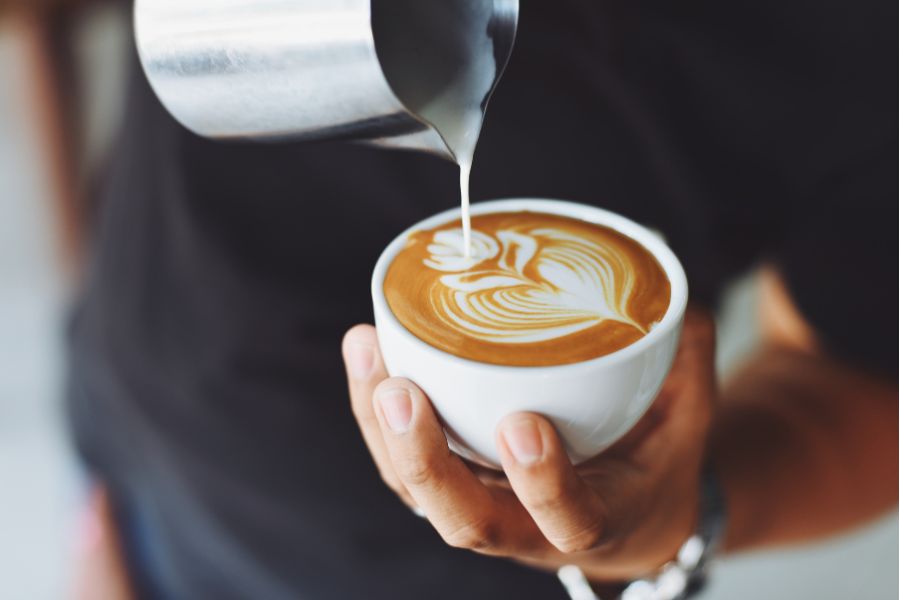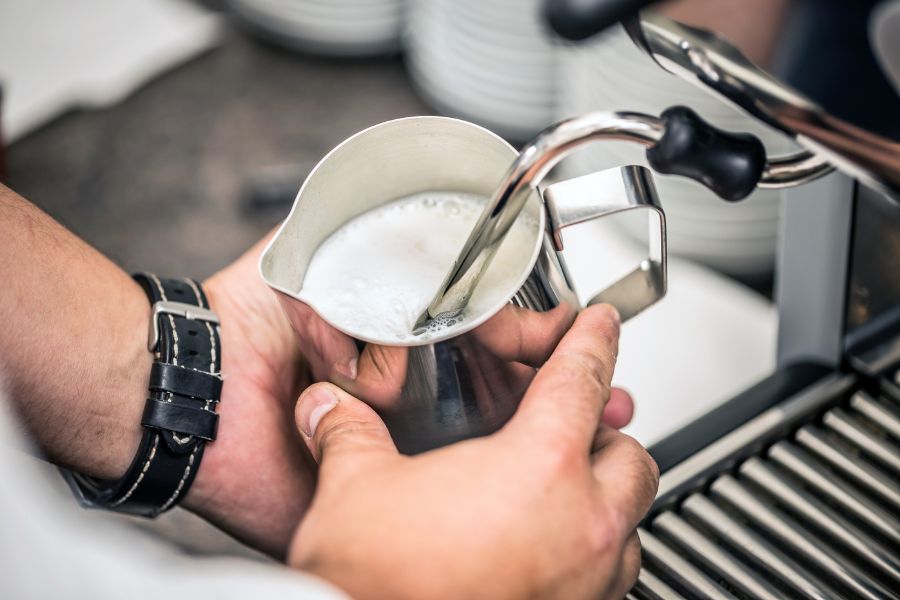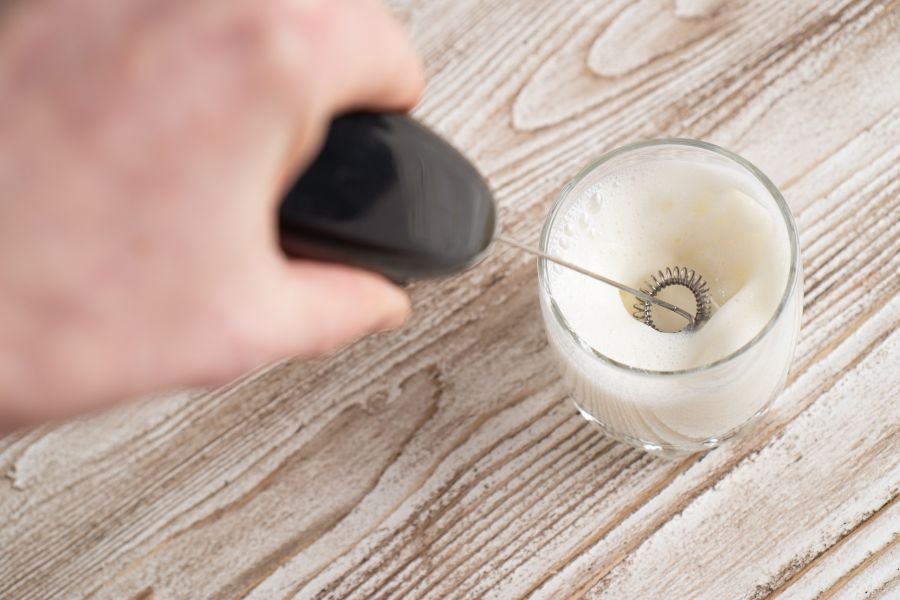Do you love cappuccinos but hate paying coffee shop prices? Have you ever wanted to make your own delicious cappuccino in the comfort of your home? If so, then you have landed on the right blog post!
I have probably made a few thousand cappuccinos in my career as a barista. Maybe even a few tens of thousands! So in this guide, I’ll show you exactly how to make a cappuccino at home like a real barista!
- What Is a Cappuccino?
- What Do You Need to Make a Cappuccino?
- How to Make a Cappuccino Like a Pro?
- What Milk Is Best For Making a Cappuccino?
- How to Foam Milk For a Cappuccino Like a Pro Barista?
- How to Pour Milk Into a Cappuccino Properly?
- Can You Make Cappuccino Foam Without a Milk Frother?
- Can You Make a Cappuccino Without an Espresso Machine?
- Conclusion

What Is a Cappuccino?
A cappuccino is a popular coffee beverage that originated in Italy. It is made by combining a shot of espresso with steamed milk and a layer of foamed milk on top.
The espresso shot is the base of the cappuccino and provides a robust flavour, while the steamed milk balances the bitterness with a sweet and creamy texture. The foamed milk on top is not just for aesthetic purposes, it also adds a smooth and velvety texture to the overall drink.
What about a short history lesson on cappuccino before I show you how to make it?
Did you know that the name “cappuccino” originates from the Italian term “cappuccio,” which means hood or cap?
The drink is named after the Capuchin friars, who wore a distinctive hood as part of their habit. The frothy foam on top of the cappuccino resembles the hood, hence the name.
Cappuccinos are typically served in a small ceramic cup and are often accompanied by sugar or cinnamon sprinkled on top. In some countries, such as the United States, flavoured syrups are added to the drink to enhance the taste.
I personally like a bit of chocolate powder on top of my cappuccino. How about you?
What Do You Need to Make a Cappuccino?
To make a delicious cup of cappuccino, one needs a few essential items.
- Firstly, an espresso machine is necessary as it creates the base of the cappuccino which is an espresso shot.
- Secondly, fresh and high-quality coffee beans are required to obtain the perfect coffee flavour and aroma.
- Furthermore, milk is an essential component of a cappuccino, which is used to create a frothy milk layer and make the drink lighter in texture.
- You also need a milk pitcher, which is useful for steaming and frothing milk.
- Lastly, cappuccino cups are not essential but if you want the perfect result, they are highly recommended.
How to Make a Cappuccino Like a Pro?
Making a perfect cappuccino requires precision and attention to detail. Here is a detailed step-by-step guide on how to make a cappuccino that’s sure to impress even the most discerning coffee connoisseurs.

- Start by picking the right coffee beans. Cappuccinos typically use dark roasted coffee beans that have a bold and rich flavour. Choose freshly roasted coffee beans to ensure the best cup of coffee.
- Grind the coffee beans and tamp them down into the portafilter of your espresso machine. Make sure the grounds are evenly packed.
- Brew a single or a double shot of espresso using an espresso machine. The espresso should have a strong flavour and golden brown crema.
- While the espresso is brewing, pour cold milk into the milk pitcher. Use whole milk for a creamier texture or skim milk for a lighter consistency.
- Froth the milk using the steam wand until it reaches a velvety foam texture. The foam should be thick and creamy, but not stiff.
- Gently swirl frother milk to remove any large bubbles.
- Pour the milk slowly into the cup. As the cup fills up, add more foam to the top to add the last layer of milk foam.
- Sprinkle a small amount of cocoa or cinnamon on top of the foam for a finishing touch.
Congratulations, you have made a delicious cappuccino!
What Milk Is Best For Making a Cappuccino?
While it is true that there are many different types of milk that can be used for cappuccino, there are a few key factors to consider if you want to achieve the perfect consistency, texture, and flavour.
Firstly, it is crucial to use cold milk when making a cappuccino.
This is because cold milk has a higher viscosity, which means that it is easier to froth and creates a more stable foam. On the other hand, milk that is too warm or hot can become too thin and watery, resulting in a flat and lacklustre drink.
In addition to using cold milk, it is also important to use high-fat milk (whole milk).
Whole milk is a great option as it can create a rich and creamy texture that complements the bold flavour of espresso. Skim or low-fat milk, on the other hand, can result in a watery and flavourless foam that detracts from the overall quality of the drink.
Another factor to consider is the freshness of the milk.
Using milk that is past its expiration date or has been sitting in the fridge for too long can lead to a sour and unpleasant taste that ruins the entire cappuccino experience.
You don’t want that sour cappuccino, don’t you?
How to Foam Milk For a Cappuccino Like a Pro Barista?
Foaming milk for a cappuccino is one of the most essential steps in crafting this world-renowned espresso drink. Follow the below steps on how to foam milk for your cappuccino like a pro barista.
First and foremost, as I mentioned earlier, make sure that you use cold, whole, and fresh milk. This is critical (sorry vegans).
Use a stainless steel milk pitcher for best results. Pour it into your milk pitcher, place the steam wand into the pitcher below the surface of the milk, and release the steam.

Hold the nozzle just below the surface of the milk and tilt the jug slightly to create a whirlpool effect. This motion helps to distribute the heat and air more evenly throughout the milk, leading to a smooth and silky texture.
Maintain the position until the milk reaches a temperature of around 150 degrees Fahrenheit. You can use a milk thermometer to know when your milk is ready.
Or you can listen closely to the sound the milk makes while it is being frothed. A gentle, velvety sound indicates the milk is being aerated correctly.
However, take care not to over-froth the milk because it can cause the foam to separate from the milk and result in a dry cappuccino.
Finally, tap the jug gently on a surface to remove any air bubbles and enhance your cappuccino’s look. Once you have frother the perfect foam, it’s time to pour!
How to Pour Milk Into a Cappuccino Properly?
The key to a perfect cappuccino is balance, and achieving this balance requires careful and precise pouring techniques. Here is how it’s done.
First, pour a small amount of milk into the espresso to create a base layer. The foam will naturally sit on top of this layer, creating a well-balanced flavour.
Next, hold the pitcher at a slight angle and pour the milk into the centre of the cup. This technique will ensure that the milk is distributed evenly throughout the coffee. The pour itself should be smooth and circular.

Don’t pour milk too fast as it can create an uneven texture and ruin the balance.
To finish the pour, add a thin layer of milk foam to the top of the cappuccino. This step is crucial, as the foam contributes to the overall texture and flavour of the cappuccino.
To remove any remaining bubbles in the foam, use a spoon to gently scoop them out.
Can You Make Cappuccino Foam Without a Milk Frother?
While a milk frother is typically used to create this foam, it is definitely possible to achieve a frothy cappuccino without one. There are a few alternative methods that you can utilise to create the perfect foam for your cappuccino.
- Using a French press: Simply heat up your milk and pour it into the French press, then pump up and down vigorously for about 30 seconds until you achieve a frothy texture.
- Using an instant frother: All you need to do is pour cold milk into the electric instant milk frother, press the button, and let it create a perfect cappuccino foam for you.
- Using a whisk: Heat your milk and pour it into a deep bowl, then using a whisk in one hand and holding the bowl in the other, whisk back and forth until you create a layer of frothy foam.
- Using a jar with a tight-fitting lid: Pour your heated milk into the jar and then shake it vigorously for about a minute until you create a luscious foam layer.
- Using a hand-held frother: Heat up your milk and pour it into a deep bowl, then using your hand-held frother, whip the milk until it thickens and develops a frothy texture.
Can You Make a Cappuccino Without an Espresso Machine?
Fear not – it is possible to make a cappuccino without an espresso machine, using affordable and everyday kitchen appliances.
To start with, you will need to make an espresso or at least a cup of strong coffee.
This can be achieved by using a moka pot, a French press, or by boiling coarse coffee grounds in water and straining them through a fine mesh sieve. Alternatively, you may use instant coffee as a quick and easy solution.
Next, you will need to froth the milk. Follow the steps from earlier to create milk foam for your cappuccino by using any of the alternative methods that don’t require investing in an expensive espresso machine.

Lastly, combine the coffee and frothed milk in a cup by following the steps from earlier.
While this method does not produce the same quality as professional espresso machines, it is a great alternative if you want to enjoy a cappuccino without spending hundreds on equipment.
Conclusion
In conclusion, making a cappuccino is not as complicated or intimidating as some may think. As you can see with the 8 steps outlined in this article, anyone can make their own delicious cappuccino in the comfort of home.
Using the right ingredients, taking your time to perfect each step, and preparing your drink with your own two hands make it all the more gratifying when taking a sip and diving into its rich flavours.
Why wait for a cafe to prep your next espresso-based beverage when you can master the art of cappuccino making on your own? Give these steps a shot. You won’t regret it—and who knows? It may become your new favourite hobby!
While you are here, why not learn how to make latte at home? Or even a perfectly balanced flat white (my favourite!)?
